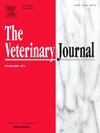Clinicopathological implications of EpCAM immunoexpression in canine gastric carcinoma and its association with other immunomarkers
IF 3.1
2区 农林科学
Q1 VETERINARY SCIENCES
引用次数: 0
Abstract
Epithelial cell adhesion molecule (EpCAM) is a transmembrane glycoprotein, and its overexpression has been reported in various human epithelial cancers, namely in gastric cancer. This study evaluated the EpCAM immunohistochemical expression pattern in canine tissue samples: non-neoplastic gastric mucosa (n = 14) and gastric carcinoma (n = 31). EpCAM was consistently expressed in all cases of non-neoplastic gastric mucosa and in 96.8 % of gastric carcinomas, 64.5 % of which showed EpCAM overexpression. EpCAM overexpression was statistically more frequent in intestinal type carcinomas (100.0 %; p = 0.036) than in diffuse-type carcinomas (47.4 %), according to Lauren classification. No statistically significant differences in EpCAM expression were observed regarding sex, age, body weight, tumour location, tumour depth and histological type according to the human WHO classification. EpCAM overexpression was associated with previously studied markers of canine gastric cancer, namely E-cadherin, TFF1, vimentin and Ki-67 and a significantly association between EpCAM overexpression and high Ki-67 proliferative index in neoplastic cells of gastric carcinomas was observed (Kappa=0.358; p = 0.042). Our results demonstrate that EpCAM is expressed in canine gastric tissues and overexpressed in gastric carcinomas, being potentially involved in the gastric carcinogenesis in dogs.
EpCAM免疫表达在犬胃癌中的临床病理意义及其与其他免疫标志物的关系。
上皮细胞粘附分子(Epithelial cell adhesion molecule, EpCAM)是一种跨膜糖蛋白,其过表达已被报道在多种人类上皮癌中,即胃癌中。本研究评估了EpCAM在犬非肿瘤性胃粘膜(n=14)和胃癌(n=31)组织样本中的免疫组织化学表达谱。EpCAM在所有非肿瘤性胃粘膜中一致表达,在96.8%的胃癌中表达,其中64.5%的胃癌呈EpCAM过表达。根据Lauren分类,EpCAM过表达在肠型癌中(100.0%,p=0.036)高于弥漫性癌(47.4%)。EpCAM的表达在性别、年龄、体重、肿瘤位置、肿瘤深度、组织类型等方面均无统计学差异。EpCAM过表达与前期研究的犬胃癌标志物E-cadherin、TFF1、vimentin、Ki-67相关,EpCAM过表达与胃癌肿瘤细胞中Ki-67高增殖指数显著相关(Kappa=0.358; p=0.042)。我们的研究结果表明EpCAM在犬胃组织中表达,并在胃癌中过表达,可能参与了犬胃癌的发生。
本文章由计算机程序翻译,如有差异,请以英文原文为准。
求助全文
约1分钟内获得全文
求助全文
来源期刊

Veterinary journal
农林科学-兽医学
CiteScore
4.10
自引率
4.50%
发文量
79
审稿时长
40 days
期刊介绍:
The Veterinary Journal (established 1875) publishes worldwide contributions on all aspects of veterinary science and its related subjects. It provides regular book reviews and a short communications section. The journal regularly commissions topical reviews and commentaries on features of major importance. Research areas include infectious diseases, applied biochemistry, parasitology, endocrinology, microbiology, immunology, pathology, pharmacology, physiology, molecular biology, immunogenetics, surgery, ophthalmology, dermatology and oncology.
 求助内容:
求助内容: 应助结果提醒方式:
应助结果提醒方式:


